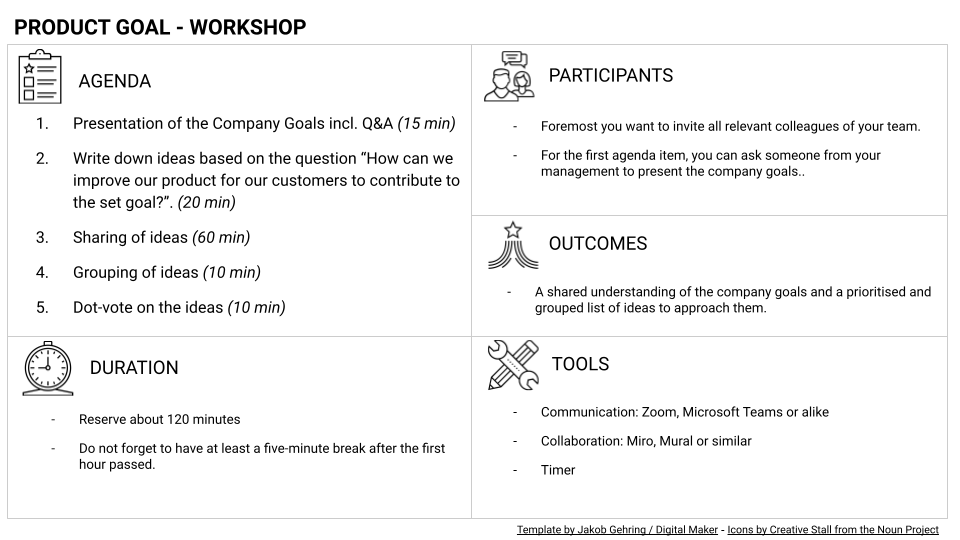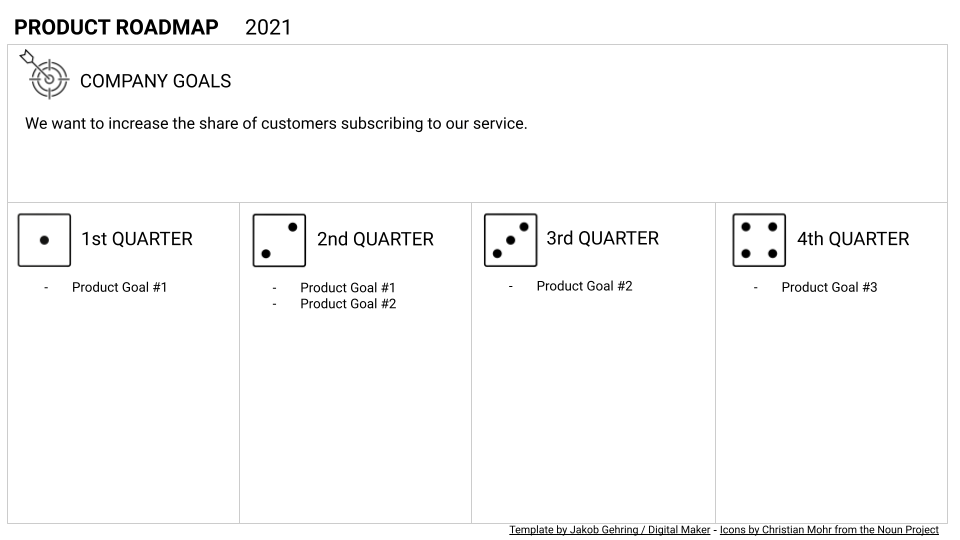One of the main tasks of a product team is continuous discovery. While the product manager does her day-to-day duties, she finds herself thinking about the next quarter. Questions will come up like “How will we evolve the product on our current initiatives?”. It is a continuous thought process that does not respect the boundaries of quarters or planning frameworks like OKR.
In the following, I explain how you can use product goals for easy planning, better communication and performance measurement for you and your team.
This thought process and the upcoming initiatives’ preparation are essential and fundamental parts of a product manager role. However, I am not talking about pre-planning in detail upfront. Instead, you should have a plan and a path on what direction you and your product team follow.
The important part is that you want to create value for your customers and the business alike and be actionable in alignment within the organisation for your overarching product goals.
Contents
Just another layer?
About two years ago, a colleague introduced me to something called Product Goals. You can define the path you and your team want to walk over the next six to twelve months with them. You can use them to communicate your ambitions towards your leadership and measure your success. They also allow you to stay on track with your initiatives as it happens too easy to get lost during the year.
You might think about why to introduce another layer of planning into the existing ones. We work with Company Visions, Company Goals, the Business and Product Strategy and slice everything in OKR. So, where do Product Goals fit in?
Product Goals vs Product Strategy
Since its new release in November, the Scrum Guide includes Product Goals. They define them to sit just on top of the product strategy. The Product Samurai describes them as “Product Goals are measurable stepping stones designed to push the threshold of knowledge towards our Product Vision.” 1
In his newest book ‘Empowered’ 2, Marty Cagan talks about the Product Strategy and its importance. In his definition, the product leader is supposed to define the product strategy. Unfortunately, the term “Strategy” is sometimes very misleading and raises, in some cases, debates about who owns the strategy, especially between the product management and business owner. Therefore, I prefer to use the term “Goal” and refer to what Cagan wrote about it, which is on point for me.
“Strategy” as a term is ambiguous as it exists at every level for just about everything—business strategy, go‐to‐market strategy, growth strategy, sales strategy, discovery strategy, delivery strategy, and so on. Whatever the goal is, your strategy is how you’re planning to go about accomplishing that goal.‘
Four step to your Product Goals
Company setup and context
Company setups are very versatile. You have small startups with one, if any, product manager, where the company owner defines the company vision but often fails to provide all layers down to tangible product goals. On the other end of the spectrum, you find big corporations with dozens of product teams. With many groups working on the same company goals, you will find a second layer of complexity: teams’ alignment.
In the end, the product manager needs to work on topics that will make a difference for your customer and impact the business. You might be the sole product manager, a group product manager for a specific business area, or the next unicorn startup founder. What I describe in the following is a way to lay a path out of how you and your team can create a storyline for your upcoming product work.
The leadership most likely sets a goal for the year. Example like “Increase number of subscriptions” or “Increase revenue by 10%” should sound familiar. Translate this to what you and your team should work on in the coming months. When you start the year, you want to know what you want to achieve by the end of the year:
- Think about ideas on how to address the set goal. You do your research and discovery in the best condition and know the most pressing issues for your customers.
- Formulate product goals out of your ideas.
- Build a rough roadmap out of the product goals to get a tool to communicate your plans and ease alignment with stakeholders and other product teams.
Ideating Topics with the Team
One approach you can use is to gather the product team and ideate on initiatives.
You can download your workshop cheat sheet via Google Slides.

I recommend setting up a session of about two hours. In our new routine of working remotely, make use of online collaboration tools 3. Present the company goals, vision or any other details your leadership provided as the wanted outcome. That’s your framework.
Depending on the structure and size of your organisation, you should split the sessions. For example, you can either have a session per product team or more high-level per business unit. I would not recommend mixing different customer personas, for instance, to create actionable goals.
Take about 15 minutes to present and answer questions. Then, you and your team will think inside this framework to come up with ideas. Raise the following question to your team.
“How can we improve our product for our customers to contribute to the set goal?”
You will see that your team and, in particular, your developers will come up with many ideas. Allow every participant about 20 minutes to write down their thoughts. After that, let everyone present their ideas, and together you group them at the end of this part. It will take about an hour, depending on the team size.
The resulting topics will be the basis for your product goals. Perform a dot voting on them afterwards to prioritise.
Defining your Product Goals
With having your prioritised list of topics, you are all set to define your product goals. You can either do it alone or better sit down with your product designer and tech lead. We aim to fill out the product goal template as good as possible, starting with the highest priority topic.
Let’s talk about prioritisation. If you start with a clean slate, you can use simple dot voting as described in the section before. However, if you already have data from your previous work and leverage a backlog of ideas, I recommend using a sizing method like ICE. I especially like the Confidence Meter from Itamar Gilad.
You can download your product goal template via Google Slides.

In the first step, take all the team’s ideas for the topic you gathered during the workshop and write them into the section titled “Ideas”.
Second, try to find a target group and the metrics you want to move and list them in the sections accordingly. You want to address a specific target group, “All users” does not create focus—the same counts for the metrics. Define one primary metric and only a couple of supporting health metrics. You might recognise that the ideas may be too widespread to accomplish this, and I recommend removing some ideas in that case.
By now, you have a clearer picture of what you want to achieve. Identify in the next step all the fuzzy things. Do you see dependencies with other teams to conclude your initiatives? Do you have questions that came up while you discussed the ideas, target group and metrics? Document all of this in the section “Open Questions”.
With all the parts in mind, you can go ahead and define your product goal. Then, write down in a sentence or two what you want to achieve and give it a crisp headline.
Repeat this for all the topics you collected in the workshop. Please keep in mind that numerous product goals are not necessarily better. Create as much as you can handle, and that depends on many factors.
- What kind of team setup do you have?
- What is the role of your team (e.g. experience or platform team)?
- What kind of goals did you name?
It makes a difference if you want to improve the account creation flow compared to creating your first mobile app.
Establishing your Roadmap
You have done the most significant part of the work. It is now time to get ready and communicate your product goals for the upcoming period. When you create your goals at the beginning of the year, you most likely want to present your plans for the next six to twelve months.
Let us make a roadmap to showcase in what order we want to approach our product goals. We want to stay super high-level with our roadmap. In the case of a period of a year, we remain on a quarterly structure. A product goal can stretch over multiple quarters. Take your product goals and distribute them across the quarters. Just keep in mind to restrain yourself from committing to too many product goals. Depending on your team structure and the goals themselves, allow a focus with a max of two goals per quarter.
You can download your product goal roadmap template via Google Slides.

Communicate & Revise
With your roadmap in place, you can communicate with your management what initiatives you target to address their goals. You can explain how you prioritised your initiatives and share what ideas you see. You can also show what metrics and target group your initiatives will influence.
As with all the things in life and especially in digital product development, many parts change, and you need to adjust permanently. The product goals provide a high-level view of your plans. Adjust them as you move forward continuously.
- You can read in detail about the Scrum Guide’s announcement of the Product Goals on their blog. https://www.scrum.org/resources/blog/product-goal ↩
- The newest book is once again an encyclopedia for product management. https://svpg.com/empowered-ordinary-people-extraordinary-products/ ↩
- We have great success by using the tool https://miro.com. ↩
Photo by Brandon Nelson on Unsplash
